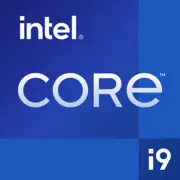Intel Core i9-11900

Intel Core i9-11900: Review and Relevance in 2025
Is the 14 nm Rocket Lake architecture worth considering in 2025?
Key Features
Architecture and Process Technology
The Intel Core i9-11900, released in 2021, is based on the Rocket Lake architecture, which became the last version of Intel's 14 nm processors. Despite its "age," the chip remains relevant for niche tasks due to its high clock speed:
- 8 cores, 16 threads;
- Base frequency — 2.5 GHz, Turbo Boost up to 5.2 GHz (one of its main advantages);
- 16 MB of L3 cache;
- Integrated Intel UHD Graphics 750 (suitable for office PCs or systems without a discrete graphics card);
- Supports PCIe 4.0 (16 lanes for GPU + 4 for NVMe).
In 2025, the 14 nm process technology appears archaic compared to the 5 nm AMD Ryzen 8000 or Intel Meteor Lake. However, for tasks sensitive to clock speed, the i9-11900 still shows decent results.
Performance
In the Geekbench 6 test (the current version for 2025):
- Single-core score: 2152 — on par with Ryzen 5 7600X (2023);
- Multi-core score: 5320 — close to Ryzen 7 5700X, but below modern 12-core CPUs.
Key Features:
- Thermal Velocity Boost — automatic overclocking at low temperatures;
- Supports DDR4-3200 memory;
- Game optimization — high core frequency is advantageous for FPS in CS2, Valorant.
Compatible Motherboards
Socket and Chipsets
The processor uses LGA 1200, which limits motherboard options to the 500 series:
- Z590 — for overclocking (e.g., ASUS ROG Strix Z590-E, $250–$400);
- B560/H570 — budget solutions with PCIe 4.0 support (MSI B560M Pro-VDH, $150–$200);
- H510 — basic motherboards without overclocking (ASRock H510M-HDV, $80–$100).
Selection Features:
- To unlock full PCIe 4.0 performance, a motherboard with the corresponding chipset (Z590/B560) is needed.
- Motherboards with Wi-Fi 6 and Thunderbolt 4 are found in the premium segment (Gigabyte Z590 AORUS Ultra, $350).
Supported Memory
The i9-11900 works only with DDR4 (up to 3200 MHz in XMP mode). By 2025, DDR5 has become the standard, but DDR4 remains cheaper:
- Recommended modules: 2x16 GB DDR4-3200 (e.g., Corsair Vengeance LPX, $70 for the set);
- Maximum capacity — 128 GB (4 slots).
Important: The processor does not support DDR5, limiting future system upgrades.
Power Supply Recommendations
With a TDP of 65 W, the i9-11900 is energy-efficient, but consider the discrete graphics card:
- For a build with RTX 4060/AMD RX 7600: 500–600 W (EVGA 600 GD, $65);
- For RTX 4080 or Radeon RX 7900 XT: 750–850 W (Corsair RM850x, $140).
Tip: Choose power supplies with an 80 Plus Gold rating for stability and efficiency >90%.
Pros and Cons
Strengths:
- Best in class single-core performance — relevant for gaming and applications like Photoshop;
- Low heat output (compared to i9-10900K);
- Supports PCIe 4.0 — fast NVMe drives (Samsung 980 Pro) operate at full speed.
Weaknesses:
- 14 nm process technology — high power consumption under load (up to 200 W in stress tests);
- No support for DDR5 and PCIe 5.0;
- Price — the new i9-11900 in 2025 costs $300, while Ryzen 5 7600 (6 cores, 5.3 GHz, DDR5) is priced at $250.
Usage Scenarios
Gaming
In games where clock speed is essential (Cyberpunk 2077, Dota 2), the i9-11900 achieves 120+ FPS when paired with RTX 4070 (1080p). However, at 4K, it hits a bottleneck with the graphics card, and the difference with Ryzen 7 7700X is minimal.
Work Tasks
- Rendering in Blender: 8 cores perform well, but lag behind the 12-core Ryzen 9 7900;
- Video Encoding: HandBrake processes a 4K video in 22 minutes (compared to 18 minutes for the Core i5-13600K).
Multimedia
Ideal for editing in Adobe Premiere Pro (with discrete GPU) and streaming thanks to Intel Quick Sync.
Comparison with Competitors
- AMD Ryzen 7 5800X (2020): Cheaper ($220), but lacks PCIe 4.0 and has lower IPC;
- Intel Core i5-13600K (2023): 14 cores, DDR5, priced at $280 — a better choice for multi-threading;
- Ryzen 5 7600 (2023): Supports DDR5 and AM5, but has only 6 cores.
Practical Assembly Tips
1. Cooling: Choose coolers like Noctua NH-U12S ($70) or Arctic Liquid Freezer II 240 (for overclocking).
2. Motherboard: If you don't plan on upgrading — B560, for maximum performance — Z590.
3. Memory: DDR4-3200 CL16 is the optimal choice.
4. Case: Ensure good ventilation (Lian Li Lancool 216).
Example build for $900 (without GPU):
- CPU: i9-11900 ($300);
- Motherboard: MSI B560M Mortar ($160);
- RAM: 32 GB DDR4-3200 ($70);
- PSU: Corsair CX650M ($80);
- Storage: WD Black SN770 1 TB ($90).
Final Conclusion: Who Should Consider the i9-11900 in 2025?
This processor is worth considering for:
- Gamers playing at 1080p with high FPS;
- Owners of LGA 1200 systems looking to upgrade without changing their motherboard;
- Enthusiasts building PCs for emulation (high core frequency).
However, for new systems, it's better to choose a CPU with DDR5 and PCIe 5.0 (Core i5-14600K or Ryzen 5 8600). The i9-11900 remains a niche solution, but at a price below $300, it can be beneficial for budget high-performance builds.
Basic
CPU Specifications
Memory Specifications
GPU Specifications
Benchmarks
Compared to Other CPU
Share in social media
Or Link To Us
<a href="https://cputronic.com/en/cpu/intel-core-i9-11900" target="_blank">Intel Core i9-11900</a>